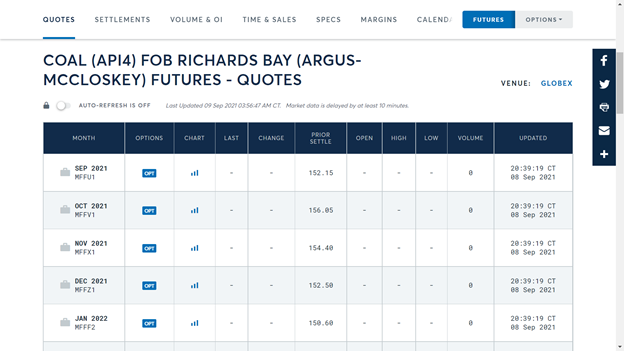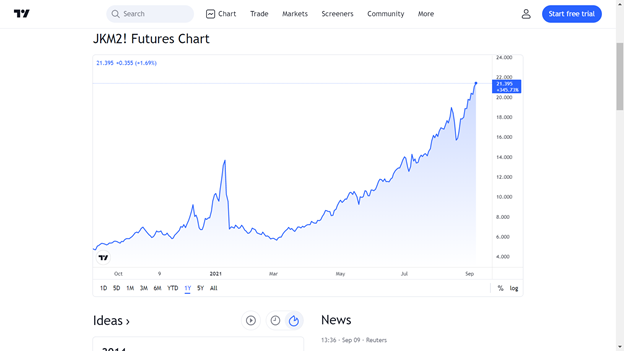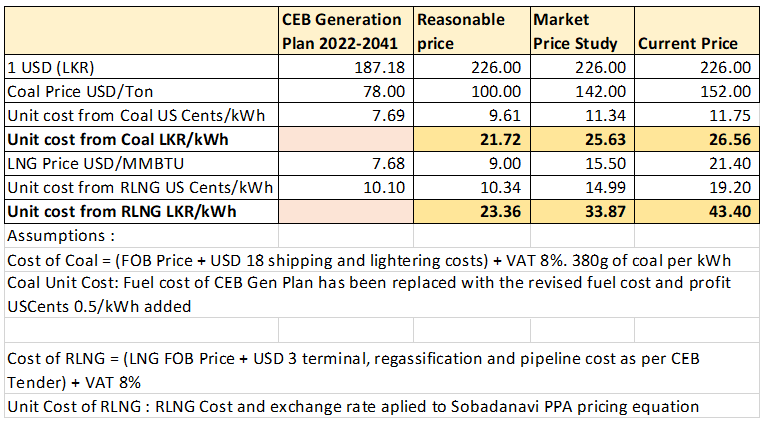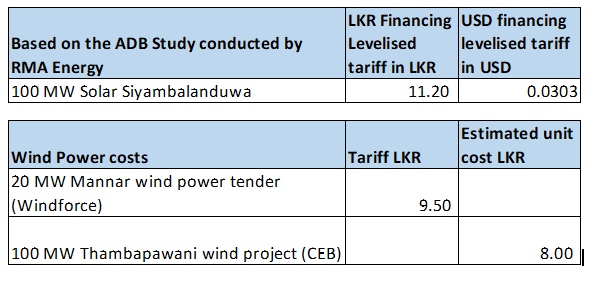Towards 70% Renewable Electricity and more by 2030
By Eng. (Dr.) Vidhura Ralapanawe
Summary
Renewable energy is currently the cheapest way to generate electricity with prices expected to reduce year on year. The state policy target of 70% renewable electricity by 2030 is technically possible and now accepted by CEB leadership . It is also the only way to provide cheap electricity to the country. Renewables are the only path to address the climate emergency and our collective responsibility. Any other route will also jeopardize our export economy and FDIs.
The Climate Emergency
The human civilization prospered during a period of relative climate stability spanning over 10,000 years. With the rapid increase of greenhouse gas emissions during the last 150 years has ended this stability, creating the current climate crisis. Global heating has resulted in increased forest fires, floods, droughts, sea level rise, cyclones of higher intensity and heat waves (marine and terrestrial). In addition to destroying human infrastructure, they also stress and endanger our increasingly fragile ecosystem integrity.

Climate is the foundation our prosperity is built on, which the Buddha understood – ‘devo vassathu kalena’ (let the gods bring rain on time).
Corals are one example – what is left is a poor remnant of what Sri Lanka had around the country. Under the 1.5°C temperature increase scenario (aspirational target of the Paris Agreement), the probability of survival of the remaining global tropical coral reefs is 3%. Under the 2°C scenario (the absolute target of the Paris Agreement) it is less than 1%. Global coral reefs declined by 50% between 1950 and 2020. Their disappearance affects comes with the risk of collapse of entire marine ecosystems and associated food chains.

As climate scientists emphasise, each year of delayed action on rapid carbon abatement, the targets move out of reach. It’s possible to use the total carbon budget of the 1.5°C scenario in the next 5 years. Thus spending 20 years ‘getting ready to make the grid carbon neutral’ makes no sense in a climate emergency.
National and Business Response
Shift to renewable/zero carbon electricity is a global phenomenon. Policy targets of some countries are given below, indicating that the Sri Lankan target is not an outlier.

The businesses are responding rapidly, joining the UN and other platforms including Science Based Targets Initiative (SBTI), with voluntary targets. Other industry bodies such as Sustainable Apparel Coalition also urge the same. Many global corporations have Paris Agreement aligned targets (55% absolute reduction of GHG emissions by 2030 and Carbon Neutrality by 2050). The first step for most companies is the rapid shift to 100% renewable electricity. Several Sri Lankan companies have also made such public commitments.
The global trading regimes are also shifting to internalizing carbon costs. The EU Green Deal introduced a Carbon Border Adjustment Mechanism (CBAM also known as the Carbon Border Tax), operational from 2023 for certain categories. Countries/companies who do not follow emission reduction trajectories (or internal carbon costs) similar to the EU will pay a tariff at the border, making these products uncompetitive.
Global brands are already imposing carbon reduction and renewable energy mandates on their supply chain. In the apparel sector, 100% rooftop electricity, 100% renewable electricity, absolute emission reduction targets aligned with SBTI are already common from companies such as Nike, Levi’s, Uniqlo, PVH, Target etc. The Sri Lankan apparel sector’s competitiveness will depend on the speed that the country decarbonizes.
Sovereign wealth funds and asset managers are doing the same. Blackrock, the world’s largest asset manager with USD 9 Trillion investments now requires the companies they invest in to have a credible Paris Agreement aligned climate plan. And they are not afraid to use their Board seats to support. Their support saw ExxonMobil get 3 independent directors supporting energy transition appointed to the Board winning against the wishes of the company. Insurers and banks shy of fossil fuel financing.
Thus, a rapid decarbonization agenda in Sri Lanka is absolutely critical for our exports as well as FDI coming into the country.
The Policy Closure
This global context is one reason Energy Policy is not left in the hands of utility technocrats and their consultants who are unable to see beyond their own narrow framing. The Cabinet of Ministers have formally approved the 70% Renewable Electricity by 2030 target, which should end the ‘perceived policy confusion’ of the CEB. That they seem to have developed a 20-year generation plan based on a single letter by the Secretary to the State Ministry of Renewable Energy simply boggles my mind. The efforts of some in the CEB to redefine the renewable electricity target to a ‘low-carbon clean energy’, one has failed.
The Energy Transition
Energy transition refers to the fundamental paradigm shift that the world is going through – like that in the telecom industry in the shifting from fixed line to smart phone technology.
The old paradigm, which relied on large, synchronous, electromechanical electricity generators (hydro, coal, nuclear and oil/gas) is being replaced by distributed, inverter-based power systems. In addition to climate, the real driving force is the low cost of renewable energy. The Australian costs for new power generation is shown below and even after adding transmission and storage costs, renewable electricity is significantly cheaper.

The baseload paradigm worked while large generators running 24x7 on coal, hydro and nuclear were the cheapest electricity. They were inflexible – and required dispatchable and peaking plants to support the demand profile.

This paradigm lost its value when renewable electricity became cheaper than the baseload power such as coal and gas. It made sense to absorb as much of cheap wind and solar – whenever they were available – making baseload redundant. In this paradigm, what is valued is not baseload or ‘firm energy’ but flexible energy. These include hydro, gas/oil, battery storage and ‘demand response (DR)’ by consumers.

This also shifts from centralized generation to distributed generation with the emergence of prosumers. It is a process of democratization of the grid where power/money shifts from a monopoly/oligopoly to masses as they too become energy generators and earn rewards, and can be seen in countries such as Australia where 25% of households are prosumers with rooftop solar installations. Australia currently boasts 650 Watts of rooftop solar per capita – the highest in the world. Sri Lanka pales in comparison with mere 16 Watts per person.
The emergence of demand response as formidable players is seen in countries in Europe and UK (LimeJump, SocialEnergy) where companies network consumer assets (distributed battery storage, air-conditioners, backup generators) to provide virtual flexible power plants as a service. These provide sub-second to longer response grid support as a service (adding or reducing power or consumption on-demand). This is much like Uber or Pickme leveraging existing vehicle and road infrastructure to provide mobility as a service.
These are not theoretical concepts – they are real life examples. Read as you might, one will find naught of these in the CEB Generation Plans. Our discourse in the electricity sector is still stuck in long gone glories of coal plants that has absolutely no part in the new energy paradigm, particularly since every ton of their fuel has to be imported. The CEB engineers appears to have missed the bus (sadly still running on diesel) completely.
The Technical Domain
We must visualize a grid dominated by inverter based variable electricity generators. The discourse is different – instead of talking about ‘mechanical inertia’ we talk of grid forming inverters (and synthetic inertia). We need to shift to shorter interval dispatch (rather than day-ahead planning) based on advanced AI based predictive tools that gives a high accuracy prediction of variable generation.
In 2015, Narendra Modi gave India a 175 GW renewable electricity target by 2022. The CEA of India didn’t spend years talking it down or contesting it. By 2020, India had Eleven Renewable Energy Management Centers with advanced predictive capabilities to support the transition based on the scoping done by GIZ in 2016. By 2021, 100GW of renewables (and 43 GW more of large hydro) is in operation with another 8GW to come by year end. <
The CEB statements of ‘making our grid carbon neutral ready’ in the 2021 proposed generation plan makes no sense since it is completely divorced from reality. Countries embracing the energy transition do not spend 20 years simply getting ready. Sri Lanka had a 2050 target for carbon neutrality in the policy already gazetted in 2019, which was co-authored by a senior CEB leader from generation planning. The absurdity of policy compliance is shown below

As for the claim of using LNG as a transition (for 20 years) also makes no sense. As the image shows, EU energy transition is straight from coal to renewables. USA with cheap fracked natural gas (not LNG) went from coal to gas to renewables. But neither is building massive coal and gas infrastructure for 20 more years.

As our power systems experts clearly state, there are NO technical barriers to achieving 70% or beyond renewable electricity in Sri Lanka – but our mindsets must change first to make this policy a reality.
The Economics of Energy Transition
Sri Lanka has no other pathway open to us than renewable electricity as they represent the cheapest option for us (as shown below), even after considering the grid and storage enhancements. That some industry insiders want to claim that fossil fuels still provide some cost advancement at a time where coal and LNG costs are at all time high is simply astounding. The following pricing charts are indicative.



How would these costs transform into a unit cost? The following chart shows the indicative figures.

Now let us compare these costs with last estimated solar and wind power costs. Even adjusting to higher exchange rates, these are substantially cheaper than coal and LNG based generation.

CEB estimates for grid enhancement
CEB officials have made statements indicating that they estimate a USD 3.5 Billion additional investment for 1000 MW battery storage and building a 400kV backbone to the system. It is a tragedy that our utility executives are producing defective figures that will mislead the public without adequate due diligence and a detailed study for the same.
Industry figures show that the cost of a 1000 MW battery storage between 2025-2030 period would cost at most a USD 750 Million – 50% of the lowest cost claimed by CEB.
As per CEB claim that 70% renewable electricity scenario requires a 400 kV backbone, we would be the only country that builds an expensive backbone merely to add renewable electricity. The modern approaches are based on optimizing overall cost of generation and transmission through use of distributed storage, to avoid building expensive transmission infrastructure beyond what is absolutely necessary. CEB can simply support larger quantum of rooftop solar (the approach taken by Australia to avoid massive spend on transmission). Australia also proposes ‘virtual transmission’ by strategic use of storage instead of building transmission. But this requires overcoming the battery phobia.
Even if we assume the CEB figure to be accurate, this still represent a small cost compared to actual savings on fuel. Our calculations indicate Sri Lanka can save USD 11.6 – 14.6 Billion in the next 20 years - CEB proposed 2021 generation plan compared with a 70% renewable plan (with renewable electricity increasing by 1.5% each year). Thus, even the USD 3.5 Billion proposed investment has a fantastic return.
Conclusion
Our conversation about modern electricity generation cannot take place in an outdated paradigm. Paradigms change sometimes because the people understand the shift and embraces it. At other times, they move out, and new groups of people who understand it take their place.
We too have a choice on how we change.
Comments by CEB GM Mr M R Ranatunga on 2nd September 2021 -
https://www.facebook.com/groups/2736176276501149/posts/4233932086725553
 Eng (Dr.) Vidhura Ralapanawe
Eng (Dr.) Vidhura Ralapanawe





